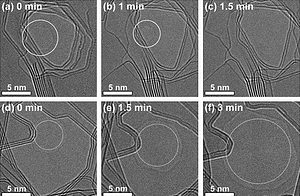Graphene is the strongest material ever discovered by man, and naturally its applications has been extended to a variety of fields – most recently genetics. University of Texas at Dallas scientists have used advanced manipulation techniques to shrink a sheet of graphene to the point that it’s small enough to read DNA. This successful attempt now opens doors for the possible introduction of graphene based, cheap DNA sequencing devices.
“Sequencing DNA at a very cheap cost would enable scientists and doctors to better predict and diagnose disease, and also tailor a drug to an individual’s genetic code,” said Dr. Moon Kim, UT-Dallas professor of materials science and engineering.

The first complete human genome sequence was finally presented in 2003 by the international scientific research group known as the Human Genome Project after more than a decade of research and $2.3 billion. Now, various institutions and scientific groups are pushing the current technological limits to reach the $1000 DNA sequencing threshold cost for a person.
With fast and cheap DNA sequencing, physicians could easily prescribe medications keeping in mind your genetic tendencies, as well as avert various serious illnesses before they can evolve by tackling your genetic predispositions. Graphene might become an essential components in such cheap DNA sequencing devices.
Because it’s so thin, but strong, the researchers saw it as a perfect candidate, and sought ways to control its pore size. The team of researchers manipulated the size of the nanopore by using an electron beam from an advanced electron microscope and in-situ heating up to 1200 degree Celsius temperature. The nanopore shrinking process can be stopped by blocking the electron beam.
“This is the first time that the size of the graphene nanopore has been controlled, especially shrinking it,” said Kim. “We used high temperature heating and electron beam simultaneously, one technique without the other doesn’t work.”
As graphene pore size control has been proven, the next logical step is to implement it into a working device, something more of a challenge.
“If we could sequence DNA cheaply, the possibilities for disease prevention, diagnosis and treatment would be limitless,” Kim said. “Controlling graphene puts us one step closer to making this happen.”
Findings were published in the journal Carbon.
via KurzweilAI


